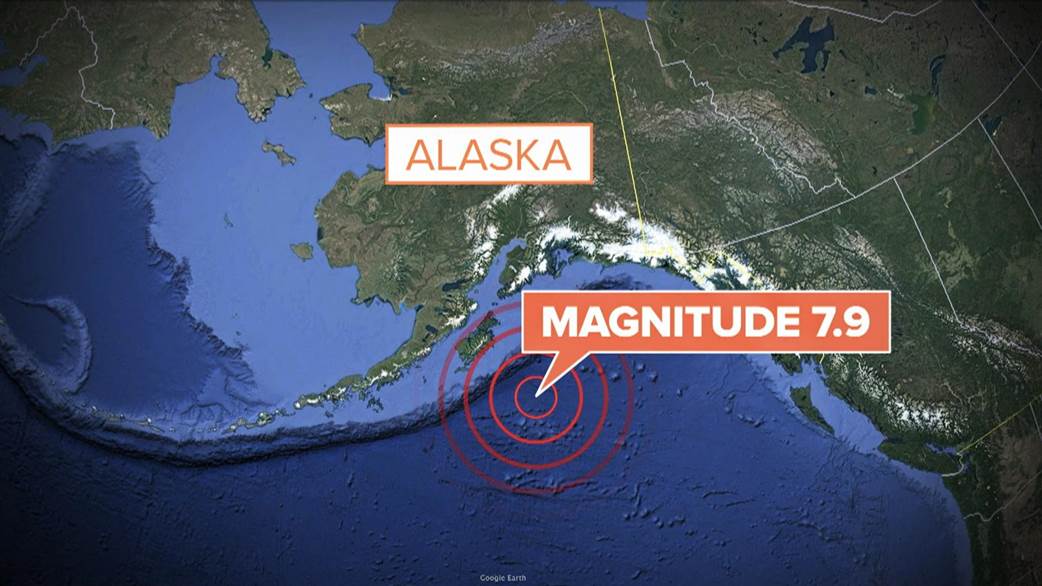
ANCHORAGE — The Alaskans, roused by a major earthquake and threatened by the specter of a tsunami, moved in the middle of the night.
They shuffled into schools that had become evacuation centers. They parked their cars on higher ground at Safeway and Walmart stores. They rushed up Pillar Mountain. Then, mercifully, the big waves never came, and within four hours, the authorities lifted the tsunami advisories that had once stretched from Alaska to the American border with Mexico.
“Everybody had to evacuate,” Fran Latham, who runs a bed-and-breakfast in Yakutat, said of her town between Anchorage and Glacier Bay National Park. “It looked like everybody was at the school and the police department.”
The overnight panic along the Pacific began after a magnitude 7.9 quake was reported at 12:31 a.m. local time in the Gulf of Alaska, according to the United States Geological Survey. There were no immediate reports of damage or fatalities, the authorities said, but the United States National Tsunami Warning Center said a small tsunami, with a wave height of less than eight inches, had been observed in a handful of Alaska cities, including Kodiak and Seward.
“We’re very grateful that there was no major tsunami,” said Mayor Pat Branson of Kodiak, a city of about 6,200 people on an island of about 13,800, at a news conference around 4:30 a.m. local time. “We live in a very prone earthquake and tsunami area, and it’s a beautiful place, but that’s what you have when you live in paradise.”

Hawaii, which this month confronted an errant alert of an incoming ballistic missile, was briefly under a tsunami watch, but much of the alarm was concentrated in Alaska, where the earthquake woke people hundreds of miles from its epicenter.
Tsunami warning sirens sounded, cellphones pinged with emergency alerts, and in Kodiak, which suffered major damage when an earthquake in 1964 sparked a tsunami, roads filled as residents rushed toward higher ground.
“I was at home asleep when I woke up with the shaking,” said Lt. Tim Putney of the Kodiak police after he evacuated his wife and children to a friend’s home that was on higher ground. “It felt like it went on for quite a while: 30 seconds or a minute or so.”
At the Hotel Captain Cook in Anchorage, the lobby shook and an urgent alert from the government appeared to unnerve some guests in the 270 or so rooms that were occupied early Tuesday.
“It was pretty crazy because for a while I just had to calm the people down,” said Michael Specking, who works at the front desk of the hotel. “Everyone in the hotel called down at once. Everybody kind of freaked out because of that alert.”
Even in Anchorage, about 350 miles from the epicenter, Mr. Specking said, “You could look over down the hall and see everything shaking. Our front doors were shaking, you could see the windows moving.”
The earthquake occurred about 175 miles southeast of Kodiak Island. This region is part of a large subduction zone, where one large piece of the earth’s surface, or plate — in this case the floor of the Pacific Ocean — is slowly sliding under another — the North American continent.
The Alaska subduction zone is the source of many earthquakes, including the one in 1964 that, at magnitude 9.2, was the second largest ever recorded.
But Peter Haeussler, a research geologist with the United States Geological Survey in Anchorage, said that the 7.9 quake on Tuesday did not occur directly where the two plates meet. Rather, he said, it appeared that the slip occurred on the Pacific plate only, at a point where it bends as it starts to slide under the continent.
The direction of the fault movement in this case would be horizontal — more like the San Andreas fault in California — and would be less likely to generate large tsunamis, Dr. Haeussler said.
The Alaska Earthquake Center, which is affiliated with the University of Alaska Fairbanks, reported a series of aftershocks, the largest of which preliminarily registered as a 5.6.
“Given the location and type of mainshock, we anticipate vigorous aftershocks in the magnitude 4-5 range and can expect aftershocks of magnitude 6 or larger,” the center said in a post on Twitter early on Tuesday. “We have no reason to suspect a follow-on earthquake of comparable, or larger, size than the M7.9 mainshock.”
In a separate post, the earthquake center said the aftershocks suggested “the fault ruptured along a North-South oriented fault.”
Tuesday’s quake came nearly seven years after Japan was rattled by a magnitude 9.0 earthquake, the strongest ever recorded there. The earthquake set off a powerful tsunami that breached the sea walls of coastal towns, killing at least 15,000 people and sparking a major crisis at the Fukushima Daiichi Nuclear Power Station.
A magnitude 9.1 earthquake, one of the most powerful ever recorded, struck off the Indonesian island of Sumatra in December 2004, generating enormous waves that killed more than 230,000 people, mostly in Indonesia but also in India, Sri Lanka, Thailand and as far away as Somalia.
In Yakutat on Tuesday, Ms. Latham recalled how she had driven, with a 90-year-old neighbor and the neighbor’s dog, through 3 feet of snow to get to safety.
“The dog thought it was great,” she said. “It was going for a ride at 1:30 in the morning.”
She eventually parked her sport-utility vehicle in the parking lot of a Catholic church. She waited. And then word from came over the radio: all clear.

